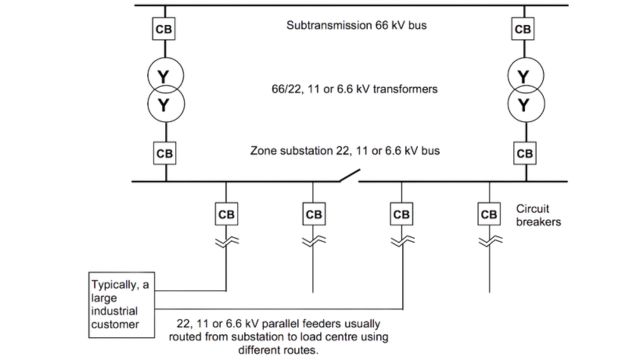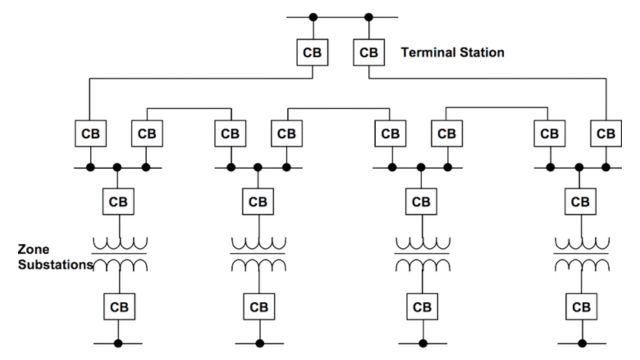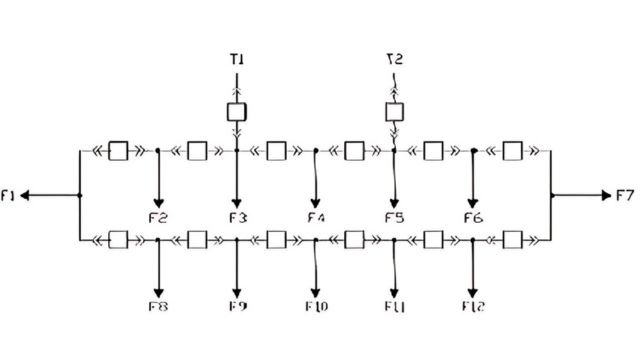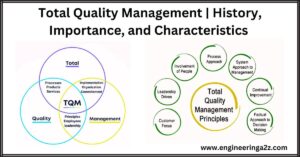
Table of Contents
Introduction
A feeder carries electricity to a substation, bus, or several loads. Different substation feeder arrangements are explained in this article. A feeder can connect two substation buses in parallel to ensure stable power and continuous service for the loads from each bus. If one source has a power plant, the tie feeder keeps the two parts of the system in sync and allows power to flow in either direction between the sources.
Types of Feeder
Understanding why and where different distribution feeder systems (topologies) are used is crucial because this knowledge is essential for designing substations, testing switchgear or transformers, and planning. Here are the main types of distribution feeder systems we’ll discuss:
- Radial distribution system
- Parallel feeders distribution
- Ring main distribution system
- Interconnected distribution
1. Radial Distribution System
A radial distribution system is used when the substation or power plant is in the center of the consumers. This system’s power lines spread out from the substation to supply electricity to the end users. The power flows in only one direction. This system is simple and has the lowest initial cost. However, it is unreliable because if there is a fault in the feeder, all connected consumers will lose power since there is no backup feeder.

2. Parallel Feeders Distribution
The disadvantage of a radial system can be reduced by using parallel feeders. This system costs more initially because it requires twice as many feeders. However, it is useful where a reliable power supply is important or for sharing high loads.

3. Ring Main Distribution System
A ring distribution system can provide reliability similar to parallel feeders. In this system, each distribution transformer is connected to two feeders through different paths. The feeders form a loop that starts at the substation, goes through the load area, and returns to the substation. The diagram below shows a typical ring main distribution system.

Advantages of Ring Main Distribution System:
Stable Voltage: There are fewer voltage fluctuations at the consumer’s end.
High Reliability: Each transformer is connected to two feeders, so if one feeder has a fault, the other can still provide power, ensuring continuous supply.
4. Interconnected Distribution
When a ring main feeder is powered by two or more substations or power plants, it is called an interconnected distribution system. This system is very reliable because if one transmission line fails, another can take over. Also, during peak load times, an area can be supplied by another substation or power plant to meet the increased power demand.

Advantages of Layout of Feeder
1. Radial Feeder:
Easy to Design: Simple structure.
Low Cost: Cheaper to install and maintain.
2. Parallel Feeders:
Reliable: Backup available if one feeder fails.
Handles More Load: Can distribute higher power loads.
3. Ring Main:
Reliable: Power can be rerouted if there is a fault.
Easy Maintenance: Can fix parts without shutting down the whole system.
4. Mesh Feeder:
Highly Reliable: Multiple pathways ensure continuous power.
Balanced Load: Evenly distributes power, preventing overloads.
Disadvantages of Layout of Feeder
1. Radial Feeder:
Low Reliability: A fault can disrupt the entire power supply.
No Backup: No alternative path for electricity flow.
2. Parallel Feeders:
High Cost: More expensive due to additional feeders.
Complexity: More complex to design and maintain.
3. Ring Main:
Moderate Cost: More costly than radial systems.
Fault Management: Faults can affect multiple connections before being isolated.
4. Mesh Feeder:
Very High Cost: Most expensive due to complex structure.
Complex Operation: Requires advanced management and control systems.
Applications of Layout of Feeder
- Radial Feeder: Ideal for small towns and rural areas with low power demands.
- Parallel Feeders: Used in urban areas and large industrial facilities for reliability.
- Ring Main: Perfect for hospitals and data centers needing continuous power.
- Mesh Feeder: Best for large cities and critical infrastructure with high-reliability needs.
Frequently Asked Questions (FAQs)
What is the primary feeder arrangement?
A primary feeder arrangement is the configuration of main power lines that distribute electricity from substations to various distribution points. It ensures efficient, reliable delivery to end users and can include radial, loop, or networked structures to optimize performance.
What is the feeder section?
A feeder section is a part of the main power line between two points, often protected by circuit breakers.
What is the use of a feeder?
A feeder is used to carry electrical power from a substation to various distribution points, ensuring efficient and reliable delivery to end users.
How are feeders helpful?
Feeders are helpful because they efficiently transport electrical power from substations to distribution points, ensuring stable and reliable power delivery. They enable load management, fault isolation, and flexibility in power distribution, enhancing overall system reliability and performance.
Related Posts
- Wind Energy | Engineeringa2z
- What is Electric Heating
- Unified Power Flow Controller | Control, Protection, and Charactersitcs
- Transmission Line | Introduction, Classification, and Modelling
- Total Quality Management | History, Importance, and Characteristics
- Tidal Energy | Working, Parts, and Applications












Leave a Reply